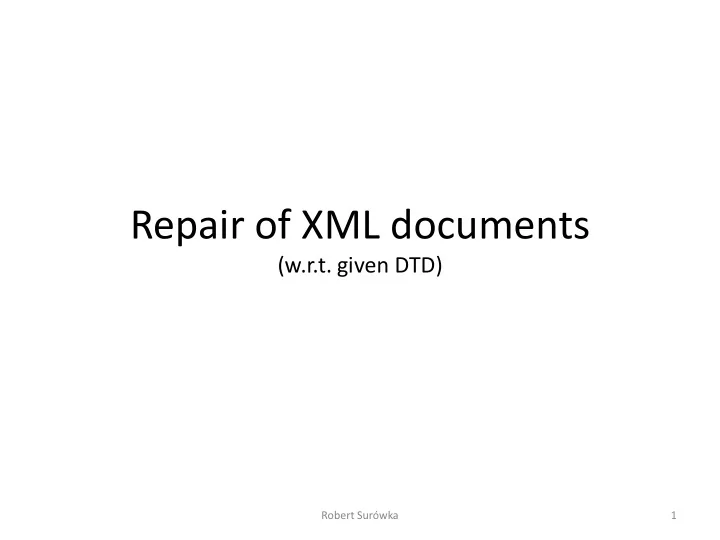

Repair ¡of ¡XML ¡documents (w.r.t. ¡given ¡DTD) Robert ¡Surówka 1
Outline ¡of ¡the ¡problem � ������������������������������ � Convert ¡given ¡xml ¡such ¡that ¡it ¡will ¡be ¡valid ¡w.r.t ¡to ¡ given ¡DTD? � Should ¡the ¡conversion ¡have ¡some ¡other ¡features? � Should ¡it ¡use ¡minimum ¡possible ¡number ¡of ¡operations? � What ¡operations ¡do ¡we ¡allow? ¡How ¡important ¡this ¡ decision ¡is? � ������������������������������������������������ repair? Robert ¡Surówka 2
Why ¡this ¡problem ¡is ¡important? � Integrating ¡XML ¡databases � ����������������������������������� � Putting ¡into ¡existing ¡XML ¡database ¡XML ¡ documents ¡found ¡in ¡the ¡Web � ����������������������������������������� � ������������������������������������������ crawling ¡(to ¡give ¡structure ¡to ¡the ¡data, ¡to ¡make ¡it ¡ more ¡usable ¡ � easier ¡to ¡search ¡through, ¡combine, ¡ aggregate) Robert ¡Surówka 3
Sample ¡repairs A <!ELEMENT ¡A ¡((((A ¡| ¡CC), ¡B)*) ¡| ¡C)> Input ¡ <!ELEMENT ¡B ¡(C)> B document <!ELEMENT ¡C ¡(C?)> C Possible ¡repairs A A A A A B C C B C C C C Robert ¡Surówka 4
Sample ¡repairs <!ELEMENT ¡A ¡((B, ¡(T ¡| ¡F))*)> A <!ELEMENT ¡B ¡(#PCDATA)> Input ¡ <!ELEMENT ¡T ¡(#PCDATA)> document B T F B T F B T F <!ELEMENT ¡F ¡(#PCDATA)> 3n ¡times Even ¡when ¡considering ¡only ¡shorterst ¡repair paths there ¡is ¡2 n of ¡repairs Robert ¡Surówka Robert ¡Surówka 5 5
Operations ¡-‑ basics A A Add ¡a ¡leaf B C B C D A Delete ¡a ¡ A B C B C leaf D A A Rename ¡a ¡ B C B E node D D Robert ¡Surówka 6
Operations ¡-‑ subtrees Add ¡a ¡ A A minimal ¡ B C B subtree D E A Delete ¡a ¡ A B C D subtree B D E Robert ¡Surówka Robert ¡Surówka 7 7
Operations ¡-‑ nodes Add ¡a ¡ A A B E node B C D C D Delete ¡ A A B C D B E D a ¡node E Robert ¡Surówka Robert ¡Surówka 8 8
Operations ¡-‑ shifts Shift ¡a ¡ A A B C B D E node D E C A Shift ¡a ¡ A B D B C D subtree C E F E F Robert ¡Surówka Robert ¡Surówka Robert ¡Surówka 9 9 9
Sample ¡existing ¡algorithms ����������������� Nobutaka ¡Suzuki PhD ¡dissertation IPSJ ¡Digital ¡Courier ¡Vol. ¡2 May ¡2007 December ¡2006 Operations ¡used: Operations ¡used: -‑ Add ¡a ¡subtree -‑ Add ¡a ¡node -‑ Delete ¡ ¡a ¡subtree -‑ Delete ¡a ¡node -‑ Rename ¡a ¡node -‑ Rename ¡a ¡node Approximate ¡Complexity: Approximate ¡Complexity: O(|t| � (|S| 2 ��� � |R|+|S| � |R| � lg(|S| � |R|))) ¡ ����� 2 w 4 |t| 2 r 2 ) ¡ t � set of nodes of the given tree, S � parameter bounded by size of the DTD, R -‑ maximum number of siblings in given tree, � -‑ set of labels in the DTD, w � maximum degree of a node in the given tree, r � maximum length of a regular expression in the DTD Robert ¡Surówka 10
������������������� 1. We ¡have ¡algorithms ¡that ¡find ¡some ¡shortest ¡repair ¡ path ¡of ¡given ¡XML ¡document. 2. Operations ¡that ¡algorithm ¡allows ¡have ¡a ¡crucial ¡ impact ¡on ¡the ¡repair. ¡ � If ¡2 ¡algorithms ¡have ¡sets ¡of ¡supported ¡operations ¡such ¡that ¡neither ¡ of ¡them ¡includes ¡the ¡other ¡then ¡neither ¡of ¡the ¡algorithms ¡always ¡ finds ¡a ¡shorter ¡repair ¡than ¡the ¡other. 3. Complexity ¡of ¡already ¡known ¡algorithms ¡is ¡ sufficiently ¡fast ¡for ¡most ¡uses. 4. ������������������������������������������� already ¡have? Robert ¡Surówka 11
Understanding ¡an ¡XML ¡document <!ELEMENT ¡Department ¡(Dean?, ¡Employees?)> ¡ ¡ ¡ ¡ ¡ ¡ ¡ ¡<!ELEMENT ¡Staff ¡(Name*)> <!ELEMENT ¡Dean ¡(Name?)> <!ELEMENT ¡Faculty ¡(Name*)> <!ELEMENT ¡Employees ¡(Faculty?, ¡Staff?, ¡Name*)> ¡ ¡ ¡<!ELEMENT ¡Name ¡(#PCDATA)> Department Department Dean Employees Employees Foo ������������������������������������������ There ¡is ¡a ¡dean, ¡whose ¡ ������������������������������������������� ��������� Foo ���������� been ¡elected ¡yet) department Robert ¡Surówka 12
An ¡unwelcomed ¡repair ¡ � data ¡corruption <!ELEMENT ¡Department ¡(Dean?, ¡Employees?)> ¡ ¡ ¡ ¡ ¡ ¡ ¡ ¡<!ELEMENT ¡Staff ¡(Name*)> <!ELEMENT ¡Dean ¡(Name?)> <!ELEMENT ¡Faculty ¡(Name*)> <!ELEMENT ¡Employees ¡(Faculty?, ¡Staff?, ¡Name*)> ¡ ¡ ¡<!ELEMENT ¡Name ¡(#PCDATA)> Operations: ¡1. ¡Add ¡a ¡node 2. ¡Delete ¡a ¡node 3. ¡Rename ¡a ¡node Department Department Employees Employees Repair Dean Moreover ¡it ¡seems ¡that ¡no ¡matter ¡what ¡ Foo operations ¡algorithm ¡would ¡support, ¡ always ¡a ¡data ¡corruption ¡may ¡happen 13
������������������������������ ����������������������������������������������������������������������������������� Realization Idea 1. ¡User ¡imposes ¡constraints ¡on ¡ possible ¡repairs ¡(e.g. ¡a ¡constraint ¡ ����������������������������� 1. ¡An ¡appropriate ¡ and ¡any ¡subtree ¡rooted ¡at ¡Dean ¡ constraint ¡language ¡needs ¡ ������������������������������� to ¡be ¡defined. prevent ¡the ¡erroneous ¡repair ¡ 2. ¡A ¡repair ¡algorithm ¡must ¡ from ¡previous ¡example). be ¡developed ¡that ¡would ¡ 2. ¡Repair ¡attempt ¡is ¡undertaken, ¡ be ¡able ¡to ¡work ¡with ¡those ¡ and ¡either ¡valid ¡(w.r.t. ¡given ¡ constraints. constraints) ¡repair ¡is ¡done ¡or ¡ information ¡than ¡no ¡such ¡repair ¡ exists ¡is ¡returned. ¡ ¡ ¡ Robert ¡Surówka 14
Alternative ¡solution A ¡lot ¡of ¡work ¡is ¡done ¡in ¡solving ¡a ¡problem ¡stated ¡like ¡this: ������������������� 1 , ¡update ¡script ¡S ¡changing ¡it ¡to ¡DTD ¡D 2 and ¡XML ¡document ¡Xin ¡D 1 ��������������������������������� 2 � So one could just define some source ����� and edit scripts transforming them to DTD in the database. Then ��������� transformation of given ����� will be far more probable E.g. ¡Nobutaka Suzuki: ¡On ¡Inferring ¡K ¡Optimum ¡Transformations ¡of ¡XML ¡Document ¡ from ¡Update ¡Script ¡to ¡DTD. ¡COMAD ¡2008: ¡210-‑221 Robert ¡Surówka 15
Choosing ¡language Creating ¡a ¡new ¡ Use ¡an ¡existing ¡ language language: � The ¡language ¡will ¡be ¡well ¡ � Many ¡of ¡users ¡will ¡be ¡ tailored ¡to ¡needs ¡(and ¡ already ¡familiar ¡with ¡the ¡ therefore ¡it ¡may ¡be ¡more ¡ language compact ¡and ¡convenient) � If ¡for ¡our ¡needs ¡some ¡ � More ¡work ¡would ¡be ¡ small ¡tweaks ¡to ¡the ¡ needed ¡to ¡create ¡that ¡ language ¡would ¡be ¡ language ¡as ¡well ¡as ¡tools ¡ needed ¡it ¡may ¡confuse ¡the ¡ for ¡it users � The ¡language ¡can ¡evolve ¡ �������������������������� Robert ¡Surówka 16
Recommend
More recommend